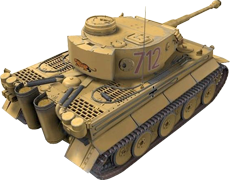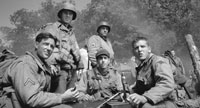SdKfz 181 PzKpfw VI Tiger I Tank

Two proposed tank designs, one from Henschel & Son and one from Porsche, were presented to Adolf Hitler on April 20, 1942, the Fuhrer's 53rd birthday. The Henschel design was judged to be superior, and this design went into production in August of 1942 as the SdKfz (special motor vehicle) 181 PzKpfw (armored fighting vehicle) VI Tiger (Ausf H). The need for the Tiger was driven primarily by the success of the Russian T-34, a tank that could best the German PzKpfw III and IV models.
Although the Tiger did have its problems, its heavy armor and massive 8.8 cm KwK 36 L/56 main gun made it (for a time) the most powerful tank on the World War II battlefield. Tanks such as the American M4 Sherman were enormously outmatched when pitted against the Tiger, and the Allies often relied on superior numbers in order to counter the offensive and defensive abilities of the Tiger.
The Tiger could outrange and outgun its competitors, but it was expensive to produce, difficult to maintain, consumed a large amount of fuel, and was made in relatively small numbers compared with Allied tank production. Although the forward armor was virtually impenetrable, the Tiger was vulnerable to attack from the rear.
Zimmerit, a paste-like material created to prevent magnetic mines from sticking to the surface of a tank, was applied to certain armored vehicles, including Tiger tanks, from late 1943 to late 1944.
As a testament to the dominance of the Tiger, most of its numbers were destroyed either by air attacks (western Europe) or a combination of air attacks and mechanical problems (eastern Europe).
Between April of 1942 and August of 1944, 1,349 Tiger tanks (including prototypes) were built by Henschel & Son in Kessel, with various components and parts being supplied by outside contractors. In contrast, the Russians built over 23,000 T-34/76 tanks between 1942 and 1945, and the United States built more than 49,000 M4 Sherman tanks during the war.
Notes
The two Tiger I replicas from Saving Private Ryan were stored at The Tank Museum in Bovington, England for a time, but they have apparently been sold and removed from the museum. It looks like one of the tanks may have found its way to the United States, as one was reportedly used for a reenactment of the Battle of Carentan in Monterey, California by the World War II Research and Preservation Society. An article on the reenactment indicates that the Tiger tank is owned by Joe Fazio of San Francisco.
Fact vs. Fiction
The two Tiger tanks featured in Saving Private Ryan are reproductions built on the chassis of Russian T-34 tanks. Operational Tiger I's are extremely rare, and could not have been used for rigorous film production, let alone a movie in which the plot requires one of them to be destroyed.
The T-34 was chosen because of its overall size and barrel height. The reproductions were based on measurements taken of a Tiger I at the Tank Museum in Bovington, England, and were constructed by Plus Film Services. The upper hull and turret were sized to proportionally match the chassis of the T-34. Band of Brothers, the HBO mini-series produced by Steven Spielberg and Tom Hanks, used a similar construction process to recreate Tiger I tanks out of readily available T-34s.
The most obvious visual difference between a real Tiger I and the reproductions are the tracks, which do not feature the Tiger I's overlapping wheel design. Although the front of the tank features the appropriate machine gun and driver's viewport, these two features are a source of great controversy.
The small machine gun of a Tiger I was normally manned by the tank's radio operator, but the gun is fired only briefly during the Battle of Ramelle—blink and you'll miss it (screen capture 1 | screen capture 2). The machine gun on the second Tiger can be seen to move slightly just before it is destroyed. It is possible that both tanks had limited ammo for their machine guns, or that one was out of ammo and the other damaged, or that both tanks had injured radio operators. An operational machine gun on just one of the tanks could have made for some dramatic moments. As it is, the limited machine gun fire in the film is so brief as to be non-existant (and one wonders if it was a post-production CGI effect).
The driver's viewport on a Tiger I featured 6 layers of armored glass, as well as another sheet just behind them. These systems would have prevented Captain Miller from simply sticking his submachine gun up to the port and spraying the inside of the driver's compartment with bullets. Curiously, just a fraction of a second before the second Tiger is destroyed by a P-51, the driver's viewport is shown as having been replaced with a flat, unconvincing piece of material with what looks to be the driver's port painted on! This can only be seen for a few frames (see screenshot number 8) , and is more than likely the result of whatever work was done to rig the tank for an explosion.
Another inaccuracy is the fact that the paratroopers easily open the tank commander's hatch, which would have been locked from the inside in order to prevent the enemy from using such an easy way to kill a tank crew. There is some criticism that the tank commanders are seen with their hatches open, thus exposing themselves to enemy fire, but this is actually a common way in which a tank commander would operate his vehicle, as it afforded him the best view of the battlefield. Obviously a tank commander had to use caution as to when and where he could safely open the hatch.
Both Tiger tanks feature the insignia of the I SS Panzer Corps, a unit that would not have been near the Merderet River on June 13th, 1944.
Because of the limited number that had been constructed, and the disposition of German forces on June 13, 1944, the date of the Battle of Ramelle, it is highly unlikely that any Tiger I tanks would have been in or around Ramelle at that time. The use of the Tiger I in Saving Private Ryan has much more to do with its reputation and popularity than historical accuracy.

